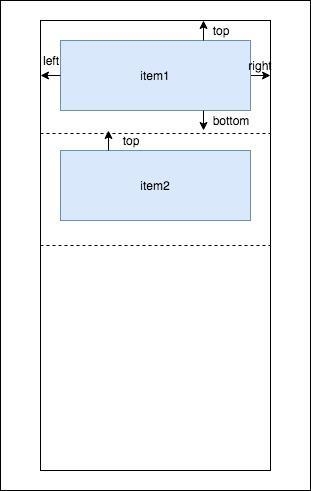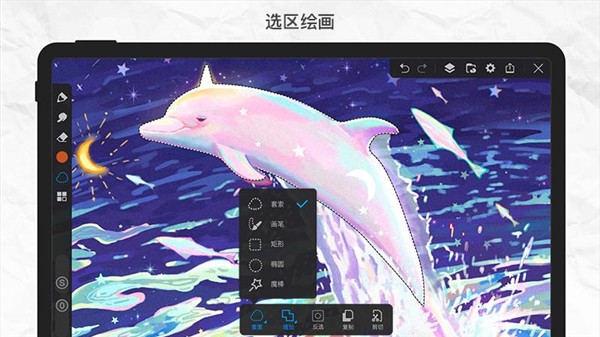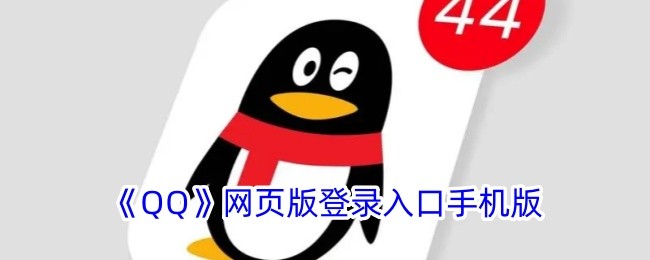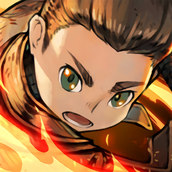Android RecyclerView区分视图类型的Divider的实现
我们都知道support库有一个DividerItemDecoration, 可以作为Item之间的分隔线(divider)。但它作用以后所有的item之间都会有这个分隔线,实际情况往往是:recyclerView中存在多种的视图类型(viewType), 我们只是需要在某一类型的视图后添加分隔线。
要实现这种分隔线效果并不是什么难事,既然是某一类型有这个分隔线,那在直接在这种视图的layout文件上增加如下一个bottomLine界面元素妥妥的:
但如果添加这样一个界面元素导致新增一层布局那感觉代价有点大。另外一种情况,如果当前这个视图由于某种原因存在padding,而期望的分隔线是穿透整个布局的,那添加bottomLine的做法也是行不通的;还有一种情况同一类型布局在一个页面有分隔线,在另一个页面没有分隔线;总之就是希望分隔线和视图内容无关。所以我们需要一种类似DividerItemDecoration的decoration,它能针对某些viewType起作用。
先要了解一下RecyclerView.ItemDecoration,它有2个重要的回调方法:onDrawOver和getItemOffsets。onDrawOver其实是一种应用多个item的方法,所以无论如何都需要一个遍历操作。需要理解的是getItemOffsets中outRect这个输出型参数,虽然是一个Rect类型,但并不表示任何范围,而只是一个item四周的间隔距离:
outRect参数各域的含义
我们思路已经很清楚了:
在getItemOffsets中判断当前view的类型(parent.getChildViewHolder(view)),
如果是我们需要的类型设置对应的bottom;在onDrawOver中我们遍历recyclerView的child,同样如果是我们需要的类型将分隔线画在对应位置上就行了;这个decoration可以针对任意一种或者几种类型设置不种的drawable,我们当前用SparseArray存储,key就是视图的viewType
private final SparseArrayCompat
同时我们可以设置这个item的高度,当Drawable为null时相当于一个透明的间隙,不为null时具有强制指定的高度。
同样我们还要考虑方向:layoutManager为横向和竖向的情况,无它,只是画的位置不同而已。
话不多说了,上代码:
import android.graphics.drawable.Drawable;
import android.support.annotation.Nullable;
import android.support.v7.widget.RecyclerView;
public class ViewTypeDivider extends ItemHolderDivider {
@Override
protected int keyFrom(RecyclerView.ViewHolder holder) {
return holder.getItemViewType();
}
public ViewTypeDivider put(int viewType, Drawable drawable) {
putDrawable(viewType, drawable);
return this;
}
public ViewTypeDivider put(int viewType, @Nullable Drawable drawable, int height) {
putHeight(viewType, drawable, height);
return this;
}
}
import android.graphics.Canvas;
import android.graphics.Rect;
import android.graphics.drawable.Drawable;
import android.support.annotation.Nullable;
import android.support.v4.util.SparseArrayCompat;
import android.support.v7.widget.LinearLayoutManager;
import android.support.v7.widget.RecyclerView;
import android.view.View;
abstract class ItemHolderDivider extends RecyclerView.ItemDecoration {
private final SparseArrayCompat mDividers = new SparseArrayCompat<>(2);
private final SparseArrayCompat mHeights = new SparseArrayCompat<>(2);
protected abstract int keyFrom(RecyclerView.ViewHolder holder);
@Override
public void onDrawOver(Canvas c, RecyclerView parent, RecyclerView.State state) {
final int childCount = parent.getChildCount();
final int width = parent.getWidth();
final int height = parent.getHeight();
for (int childViewIndex = 0; childViewIndex < childCount; childViewIndex++) {
final View view = parent.getChildAt(childViewIndex);
RecyclerView.ViewHolder holder = parent.getChildViewHolder(view);
int key = keyFrom(holder);
if (isVertical(parent)) {
drawBottom(c, key, (int) view.getY() + view.getHeight(), width);
drawTop(c, -key, (int) view.getY(), width);
} else {
drawRight(c, key, (int) view.getX() + view.getWidth(), height);
drawLeft(c, -key, (int) view.getX(), height);
}
}
}
@Override
public void getItemOffsets(Rect outRect, View view, RecyclerView parent,
RecyclerView.State state) {
RecyclerView.ViewHolder holder = parent.getChildViewHolder(view);
int key = keyFrom(holder);
if (isVertical(parent)) {
outRect.bottom = getHeight(key);
outRect.top = getHeight(-key);
} else {
outRect.right = getHeight(key);
outRect.left = getHeight(-key);
}
}
private void drawBottom(Canvas c, int key, int y, int width) {
Drawable d = mDividers.get(key);
if (d != null) {
d.setBounds(0, y, width, y + getHeight(key, d));
d.draw(c);
}
}
private void drawTop(Canvas c, int key, int y, int width) {
Drawable d = mDividers.get(key);
if (d != null) {
d.setBounds(0, y - getHeight(key, d), width, y);
d.draw(c);
}
}
private void drawRight(Canvas c, int key, int x, int height) {
Drawable d = mDividers.get(key);
if (d != null) {
d.setBounds(x, 0, x + getHeight(key, d), height);
d.draw(c);
}
}
private void drawLeft(Canvas c, int key, int x, int height) {
Drawable d = mDividers.get(key);
if (d != null) {
d.setBounds(x - getHeight(key, d), 0, x, height);
d.draw(c);
}
}
final void putDrawable(int key, Drawable drawable) {
mDividers.put(key, drawable);
}
final void putHeight(int key, @Nullable Drawable drawable, int height) {
if (drawable != null) {
mDividers.put(key, drawable);
}
mHeights.put(key, height);
}
private int getHeight(int key) {
Drawable d = mDividers.get(key);
return getHeight(key, d);
}
private int getHeight(int key, @Nullable Drawable d) {
int index = mHeights.indexOfKey(key);
return index < 0 ? d == null ? 0 : d.getIntrinsicHeight() : mHeights.valueAt(index);
}
private boolean isVertical(RecyclerView parent) {
RecyclerView.LayoutManager layoutManager = parent.getLayoutManager();
return !(layoutManager instanceof LinearLayoutManager) ||
((LinearLayoutManager) layoutManager).getOrientation() == LinearLayoutManager.VERTICAL;
}
}
相关文章
精彩推荐
-
 下载
下载猪笼城寨手游
模拟经营 猪笼城寨手游猪笼城寨游戏是非常好玩的一款模拟经营类型的手游,在这里玩家们
-
 下载
下载商道高手vivo版本
模拟经营 商道高手vivo版本商道高手vivo版是一款商战题材的模拟经营手游,游戏画面精美
-
 下载
下载我在大清当皇帝手游
模拟经营 我在大清当皇帝手游我在大清当皇帝手游是一款以清代为历史的模拟类手游,相信玩家们
-
 下载
下载解忧小村落最新版2024
模拟经营 解忧小村落最新版2024解忧小村落游戏是非常好玩的一款休闲放置经营类型的手游,在这里
-
 下载
下载洋果子店rose2中文版
模拟经营 洋果子店rose2中文版洋果子店rose2中文版是一款非常好玩的模拟经营手游,精美的
















